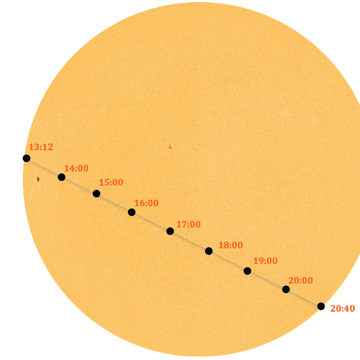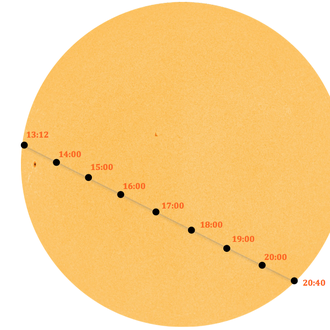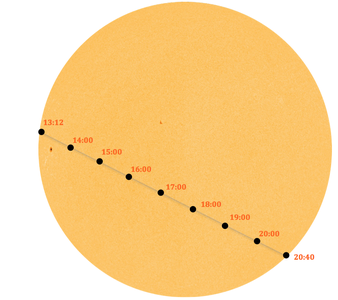Mercury crosses the Sun - Transit on 9 May 2016
On the 9th of May at 1:12 p.m. local time, Mercury will begin its transit in front of the Sun – seen from the point of view of our Earth.
It will take more than seven hours for the planet to complete its path across the solar disc, and the transit will end at 8:40 p.m. The Leibniz Institute for Astrophysics Potsdam (AIP) is preparing for the scientific exploitation of this transit event: scientists want to detect sodium in Mercury’s exosphere and at the same time test the accuracy of their instruments for further studies. They will observe the Sun during the transit of Mercury with telescopes in Tenerife, in Arizona and at the solar observatory Einstein Tower in Potsdam. In addition, the AIP invites the public to its research campus in Potsdam-Babelsberg for public observations and talks about the transit of Mercury from 1–3 p.m.
Scientific Observations
With a diameter of only 4,878 kilometres, Mercury is the smallest planet of our solar system, and the closest one to the Sun. Its gravitational force is too small to generate a stable atmosphere: only a very thin mixture of gas, called the exosphere, surrounds the planet. This exosphere mainly consists of oxygen, sodium and helium. It has such a low density that it is extremely hard to probe its structure. Only the rare transit events – like the upcoming one on the 9th of May – or space probes make such studies feasible. The last transit of Mercury that was visible from Central Europe occurred in 2003, the next such event will take place in 2019. AIP scientists therefore take this rare opportunity to observe the 2016 transit with various telescopes and instruments and from three different locations.
In Arizona: preparing for exoplanet studies
AIP scientist Matthias Mallonn will try to detect a signal of the exosphere of Mercury, using the PEPSI spectrograph coupled to the Solar-Disc Integrated Telescope (SDI) on the 3,200-meter high Mount Graham in Arizona. To do so, he will compare measurements of sodium absorption before, during and after the transit. This methodology, called transmission spectroscopy, is currently the most successful approach for studying the atmospheres of extrasolar planets. The exosphere of Mercury will reduce the intensity of solar light at the wavelength of sodium by a factor of only about one hundred thousand. This extremely small effect can only be detected with an extremely precise spectrograph: „We are taking data of the complete solar disc and therefore only obtain a very tiny signal of the exosphere of Mercury. I want to use these observations to assess the achievable precision of my method and to use this experience for later detections of exoplanet atmospheres”, Mallonn explained.
In Tenerife and in Potsdam: shape of the exosphere
Led by Carsten Denker, the solar physicists of AIP will focus observations on the detailed shape and the extension of the exosphere of Mercury. This was studied for the first time with the help of sodium absorption lines during a transit in 2003. Jointly with colleagues from Freiburg, Germany and from Spain, Denker now plans similar measurements during this transit of Mercury using a 2D spectrograph at the European GREGOR solar telescope in Tenerife and the team is hoping to also improve the accuracy of previous studies. In addition they use a high-speed camera and adaptive optics to achieve pin sharp images of the transit event. “The transit of Mercury is a unique chance for us to calibrate our instruments and methodology of observations”, Denker said. “Once we know how accurately we are able to distinguish between the sharp edge of the planet and the solar disc, we can also determine the general influence of stray-light on any observations with GREGOR.” If the weather permits, the astronomers also plan to point the mirror of the solar observatory Einstein Tower in Potsdam towards mercury, to study and document its transit across the Sun.
Public observations in Potsdam-Babelsberg: 1 to 3 p.m.
AIP invites all interested people to a public event that accompanies the transit of Mercury. The programme, at the research campus Potsdam-Babelsberg, includes talks (in German) and – if the skies are clear – public observation of the transit.
1p.m.: Observation of the start of the transit
1:30p.m: Talk by Dr. Axel Schwope: „Der Planet Merkur im Portrait“
2p.m: Talk by Dr. Matthias Mallonn „Der Merkurtransit als Generalprobe für die Erforschung erdähnlicher Planeten“
2:30p.m: Observation of the transit with the 50cm telescope
Media Contact:
Kerstin Mork, +49 331 7499-803, presse@aip.de
Science Contacts:
Dr. Matthias Mallonn, +49 331 7499-539, mmallonn@aip.de
Apl. Prof. Dr. Carsten Denker, +49 331-7499-297, cdenker@aip.de
On the 9th of May at 1:12 p.m. local time, Mercury will begin its transit in front of the Sun – seen from the point of view of our Earth.
It will take more than seven hours for the planet to complete its path across the solar disc, and the transit will end at 8:40 p.m. The Leibniz Institute for Astrophysics Potsdam (AIP) is preparing for the scientific exploitation of this transit event: scientists want to detect sodium in Mercury’s exosphere and at the same time test the accuracy of their instruments for further studies. They will observe the Sun during the transit of Mercury with telescopes in Tenerife, in Arizona and at the solar observatory Einstein Tower in Potsdam. In addition, the AIP invites the public to its research campus in Potsdam-Babelsberg for public observations and talks about the transit of Mercury from 1–3 p.m.
Scientific Observations
With a diameter of only 4,878 kilometres, Mercury is the smallest planet of our solar system, and the closest one to the Sun. Its gravitational force is too small to generate a stable atmosphere: only a very thin mixture of gas, called the exosphere, surrounds the planet. This exosphere mainly consists of oxygen, sodium and helium. It has such a low density that it is extremely hard to probe its structure. Only the rare transit events – like the upcoming one on the 9th of May – or space probes make such studies feasible. The last transit of Mercury that was visible from Central Europe occurred in 2003, the next such event will take place in 2019. AIP scientists therefore take this rare opportunity to observe the 2016 transit with various telescopes and instruments and from three different locations.
In Arizona: preparing for exoplanet studies
AIP scientist Matthias Mallonn will try to detect a signal of the exosphere of Mercury, using the PEPSI spectrograph coupled to the Solar-Disc Integrated Telescope (SDI) on the 3,200-meter high Mount Graham in Arizona. To do so, he will compare measurements of sodium absorption before, during and after the transit. This methodology, called transmission spectroscopy, is currently the most successful approach for studying the atmospheres of extrasolar planets. The exosphere of Mercury will reduce the intensity of solar light at the wavelength of sodium by a factor of only about one hundred thousand. This extremely small effect can only be detected with an extremely precise spectrograph: „We are taking data of the complete solar disc and therefore only obtain a very tiny signal of the exosphere of Mercury. I want to use these observations to assess the achievable precision of my method and to use this experience for later detections of exoplanet atmospheres”, Mallonn explained.
In Tenerife and in Potsdam: shape of the exosphere
Led by Carsten Denker, the solar physicists of AIP will focus observations on the detailed shape and the extension of the exosphere of Mercury. This was studied for the first time with the help of sodium absorption lines during a transit in 2003. Jointly with colleagues from Freiburg, Germany and from Spain, Denker now plans similar measurements during this transit of Mercury using a 2D spectrograph at the European GREGOR solar telescope in Tenerife and the team is hoping to also improve the accuracy of previous studies. In addition they use a high-speed camera and adaptive optics to achieve pin sharp images of the transit event. “The transit of Mercury is a unique chance for us to calibrate our instruments and methodology of observations”, Denker said. “Once we know how accurately we are able to distinguish between the sharp edge of the planet and the solar disc, we can also determine the general influence of stray-light on any observations with GREGOR.” If the weather permits, the astronomers also plan to point the mirror of the solar observatory Einstein Tower in Potsdam towards mercury, to study and document its transit across the Sun.
Public observations in Potsdam-Babelsberg: 1 to 3 p.m.
AIP invites all interested people to a public event that accompanies the transit of Mercury. The programme, at the research campus Potsdam-Babelsberg, includes talks (in German) and – if the skies are clear – public observation of the transit.
1p.m.: Observation of the start of the transit
1:30p.m: Talk by Dr. Axel Schwope: „Der Planet Merkur im Portrait“
2p.m: Talk by Dr. Matthias Mallonn „Der Merkurtransit als Generalprobe für die Erforschung erdähnlicher Planeten“
2:30p.m: Observation of the transit with the 50cm telescope
Media Contact:
Kerstin Mork, +49 331 7499-803, presse@aip.de
Science Contacts:
Dr. Matthias Mallonn, +49 331 7499-539, mmallonn@aip.de
Apl. Prof. Dr. Carsten Denker, +49 331-7499-297, cdenker@aip.de
Images
Transit of Mercury.





